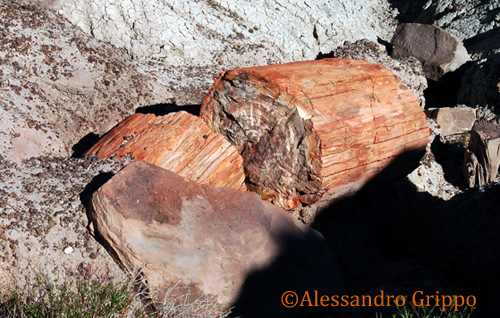
| |||||||||||||||
| Introduction | Last Updated • September 5, 2022 | ||||||||||||||
This semester we will study the basics of Earth History together with an investigation of the changes that our dynamic planet went through during its 4.6 billion years history. This class has no prerequisites and is avalaible to all students. We need then to start our discussion from scratch, and very often a time-consuming learning curve that is based on names, principles, methods, and concepts might take the fun out of the learning experience. Often students (and the professor) would love to know rocks and fossils directly, go out in the field, touch the samples, have them in their hands. While field activities would represent an ideal complement to the class, the approach we are taking will get us as close as possible to that "direct knowledge " experience. "Fossil Ecosystems of North America" provides a guide to real, different fossil records that have been discovered in distinct parts of North America; each of these records shares a specific tie to our work in the classroom and in the lab. All of the locations mentioned in the book can be visited and fossils can be observed and studied, either in the field or in museums, and they are often of exceptional quality. The book describes the geological and paleontological circumstances relative to some exceptional fossil finds from our continent, and puts them in the context of the evolution of life on Earth, from very old finds to more recent ones. We will be able to locate these fossils in time, and in space. Some of these fossil are so noteworthy that they are at the center of world renown museum collections, or are the cause for the institution of a National Park to protect them, to favor scientific work, and to spread knowledge. Fossils, as we will see during the course of our classwork, are the remnants of ancient life forms, or of their activity. Fossils are not particularly common, and many are scattered within rocks, or broken, or in poor conditions. The fossils described in "Fossil Ecosystems of North America" instead are special: contrarily to most fossils, they are exquisitely preserved, providing a lot of detail that is normally lost under normal conditions. The deposits containing these fossils (or fossil associations) are called Lagerstätten, a German word meaning approximately "place of storage". 
The fossil skeleton of a snake from the Green River Formation Lagerstätte (page 186)
| studying "Fossil Ecosystems of North America"
| Last Updated • September 5, 2022 | Introduction Most of the time you will be quizzed on the reading assignments from Nudd and Selden's book on a weekly basis. One reading assignment typically consists of one individual book chapter (occasionally you will have to cover a couple of chapters). I will be providing a series of web pages (the relative links will be listed below) with an introduction to each single book chapter and to its significant points, helping you figure out the type of information you need to get out of them.
First, I would start by saying that I strongly recommend that you begin working on this book by reading the information on its back cover (present in the paperback edition), and then browse its Table of Contents. From the chapter titles, get an idea of what the book is about and notice the progression of topics from Chapter 1 to Chapter 14. After you have done that, read the preface (page 6). You are now ready to start going over the introduction (pages 8 to 11). What is the best way for you to read and understand the book materials, and retain the information? My suggestion is that, at the beginning of the semester, you start by taking a look at the chapters' layout. Look at the index, figure out the logic behind that order. There is a pattern. That pattern is repeated throughout the book chapters. What are the authors doing, why, and in what manner do they do it?
Every chapter provides you with - in order - a general background, a geological introduction, a description of the fossil finds, a paleoecological setting. (In the appendix, for the curious student, there is a list of museums, quarries, and other localities where these fossils can actually be seen directly). Before a quiz, start reading the material in the appropriate order; establish the framework of that particular Lagerstätte and continue from there; browse the paragraphs, look at the figures, get an idea of what the chapter is about. This whole process will take 15 minutes or less. Once you build your own mental framework for the materials, start over and study the whole chapter in detail. You will not need to know ALL the materials within a chapte: I specify what you need to know out of each chapter in the reading guides I posted below. What I am saying in the end is that you need to take your time in reading these materials. Do not rush in at the last minute. Get an overall idea. After you are done reading that chapter, you are expected to know, among other things, the environments of deposition, the type of creatures you are dealing with (only occasionally - and I will let you know - the names of the fossils), the relative time frame of the fossil deposit, its significance, etc. While at first you might not know exactly what all of these are, or what they mean, you will find out that with the passing of time and constant study you will be able to grasp these concepts very easily and possibly be awed by what we can learn by being able to read the rock record and the fossil record.
In the end, I am providing you with detailed information about all of the book chapters, but it is you that will be reading these materials on your own. Please, do not think it will be enough to read a single chapter just once, or that you briefly review it and pick up the main points before the quiz: you will soon realize that such an approach will not work. You need to know the materials well. Taking time to work with "Fossil Ecosystems of North America" will give you an idea of what the book is about and what thread keeps it together. It will be a rewarding experience and will ultimately set the right tone for a better understanding of the whole class materials, and - above all- it is worth it because it will pay off in terms of both excellent grades and personal knowledge.

A silicified log from the Chinle Group Lagerstätten (page 138)
| © a guide to reading the book's chapters
| Last Updated • September 5, 2022 | Any other person, in any other state or country, using these materials for any reason is in violation of copyright.
week 5 (week of September 27, 2022): exam #1
week 10 (week of November 1, 2022): exam #2 (no quiz) week 15 (week of December 6, 2022): exam #3, part 1 (no quiz) week 16 (week of December 13, 2022): exam #3, part 2 (no quiz)
© Alessandro Grippo, since 1994 | |||||||||